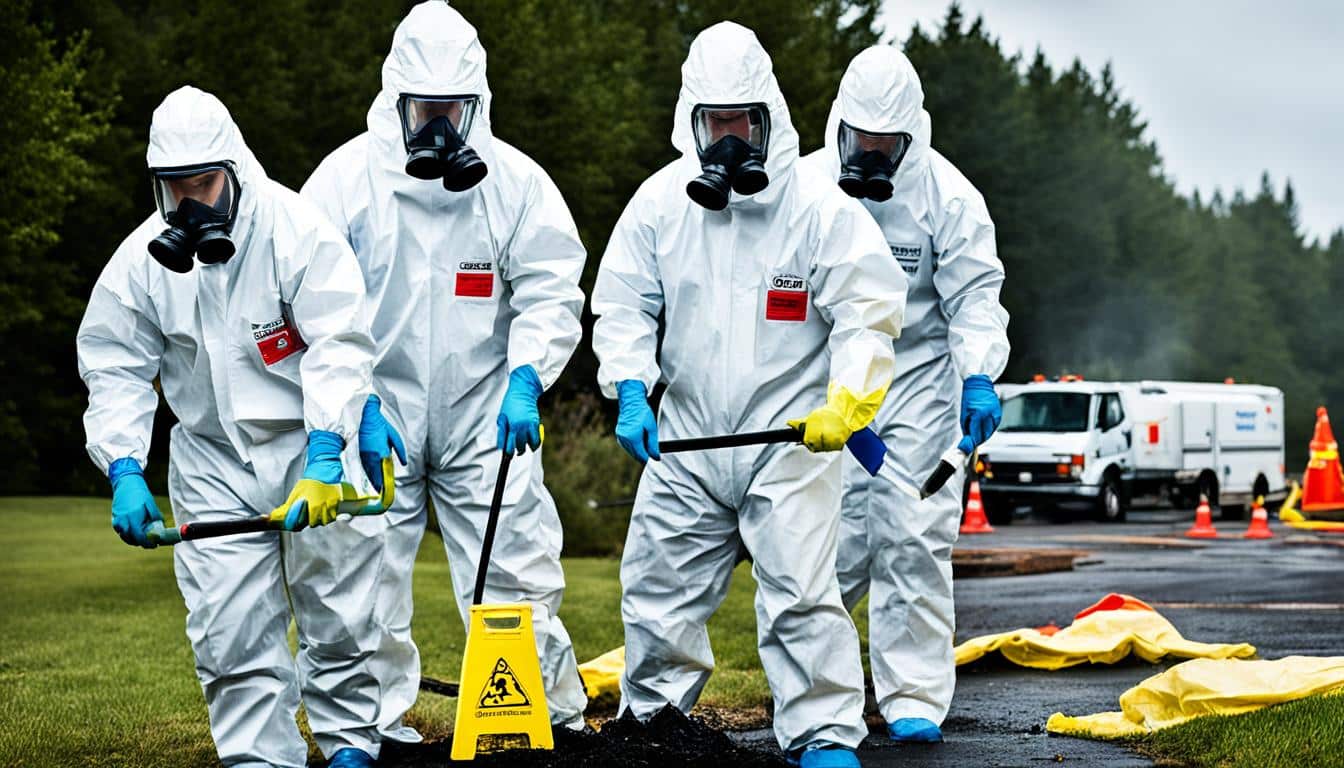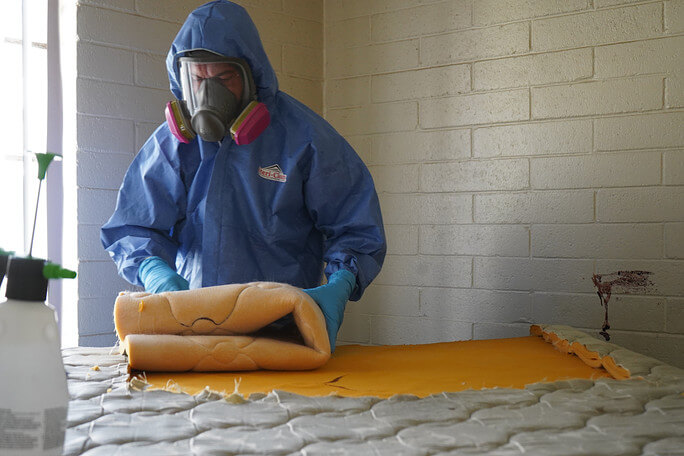Expert Biohazard Cleaning for Criminal Offense Scenes, Injury Incidents, and Infected Spaces
In the world of specialist biohazard cleanup, careful focus to detail and adherence to security methods are paramount. When faced with the after-effects of a crime scene, trauma event, or any type of infected space, the relevance of correct cleaning can not be understated. The complexities and dangers related to biohazards need customized expertise and know-how to make certain effective remediation. As we look into the details of biohazard cleanup for these sensitive environments, a deeper understanding of the challenges and vital treatments entailed will certainly arise, clarifying the crucial duty of specialist cleaning solutions in recovering safety and security and satisfaction.

Significance of Biohazard Cleaning
Biohazard clean-up adhering to criminal offense scenes and injury occurrences is crucial for making sure the safety of individuals and the setting. When these incidents take place, they typically leave a variety of biohazards such as blood, bodily liquids, and various other potentially contagious products. These substances can harbor hazardous virus like bacteria and viruses, positioning severe wellness risks if not appropriately cleansed and sterilized.
Expert biohazard cleaning solutions are trained to deal with these harmful products securely and properly. They have the necessary equipment, such as personal protective gear and specialized cleaning up representatives, to extensively sanitize the influenced locations. By delegating the cleanup to qualified experts, individuals can prevent direct exposure to dangerous virus and protect against the spread of infectious conditions.
Moreover, proper biohazard cleanup is essential for protecting the environment. Improper disposal of biohazardous materials can infect dirt, water resources, and air, presenting a danger to wildlife and the community. By following strict cleanup protocols, specialists can make certain that biohazards are securely eliminated and taken care of according to guidelines, reducing the risk of environmental contamination.
Sorts Of Biohazards Encountered
Numerous harmful materials commonly encountered in criminal activity scenes and injury events present significant health threats otherwise dealt with correctly. Blood and physical liquids are amongst the most common biohazards found in these situations. These liquids can bring pathogens such as HIV, liver disease B and C, and other dangerous microorganisms. Additionally, cells, body organs, and body components can likewise pose serious health risks as a result of prospective contamination.
Another sort of biohazard typically run into is sharp objects like needles, busted glass, and other products that can create injuries and send infections. Chemical hazards are likewise a problem, as crime scenes may have substances like tear gas, pepper spray, or medication production products that require specific handling and disposal treatments to avoid additional injury.
Furthermore, mold and germs development can take place in spaces where decay or long term direct exposure to moisture has happened. These microbes can launch contaminants and allergens into the air, positioning breathing dangers to those revealed. On the whole, biohazard cleaning professionals must be experienced and well-appointed to effectively deal with these different sorts of dangerous materials to guarantee the security of themselves and others.
Devices and Protective Gear
When addressing the essential task of managing biohazards encountered in criminal activity scenes and trauma incidents, the use of correct equipment and safety equipment is paramount to making sure the safety and security of individuals you could look here included in the cleaning process. Specialized cleaning tools like biohazard bags, anti-bacterials, and sharps containers are necessary for the risk-free collection and disposal of polluted products. Making certain that all equipment is correctly preserved, consistently examined, and utilized according to safety and security standards is important in lessening the threat of exposure to biohazards during clean-up operations.
Cleaning Process and Techniques
Detailed and efficient cleanup of biohazardous materials from crime scenes and trauma incidents requires meticulous attention to information and adherence to rigorous safety and security methods. The clean-up process commonly involves numerous vital actions. At first, the area must be assessed to determine the level of contamination and the ideal cleansing methods needed. Next, all biohazardous products, consisting of blood, bodily fluids, and cells deposits, need to be very carefully gotten rid of and dealt with based on local policies.
Following the removal of biohazardous materials, the affected area undertakes a comprehensive cleaning and disinfection process. This action includes using specialized cleansing agents and tools to make sure that all traces of contamination are check it out removed. After cleaning, the area undergoes extensive screening to verify that it is totally free and safe of any type of staying biohazards.

Purification and Disposal Procedures
To guarantee thorough decontamination and correct disposal of biohazardous products, adhering to the meticulous cleanup process, details treatments should be thoroughly followed with strict adherence to safety methods. Purification includes the removal or neutralization of contaminants to minimize the threat of exposure and spread of hazardous materials. This procedure normally consists of cleaning, disinfecting, and disinfecting the afflicted area making use of customized devices and EPA-approved chemicals.
When decontamination is finished, proper disposal of biohazardous products is essential to stop additional contamination or harm. Biohazardous waste, such as blood-soaked products or bodily liquids, need to be thoroughly accumulated, packaged, and identified according to regulatory standards. ATP testing. These materials are after that carried to licensed facilities for disposal via appropriate channels, guaranteeing conformity with local, state, and government regulations

Conclusion
In conclusion, specialist biohazard cleaning is critical for making certain the secure and efficient elimination of unsafe materials from crime scenes, trauma cases, and polluted spaces. By making use of customized devices, protective equipment, and complying with proper cleaning procedures and techniques, biohazard cleaning teams can effectively sanitize and dispose of biohazards, minimizing the threat of direct exposure and harm to people and the atmosphere.
As we delve into the details of biohazard clean-up for these sensitive atmospheres, a much deeper understanding of the challenges and critical treatments involved will certainly emerge, losing light on the vital role of specialist cleanup solutions in restoring safety and security and tranquility of mind.
Expert biohazard cleanup services are educated to deal with these hazardous materials securely and efficiently. By complying with rigorous cleanup methods, professionals can make sure that biohazards are securely removed and disposed of in conformity with regulations, reducing the threat of ecological contamination.
In general, biohazard cleaning professionals should be well-equipped and skilled to efficiently take care of these various types of dangerous products to make certain the safety of themselves and others.
When dealing with the important job of dealing with biohazards come across in criminal activity scenes and injury incidents, the usage of correct equipment and protective gear is critical to making certain the safety of individuals entailed in the cleaning procedure.
Comments on “Biohazard Removal: Safe Handling and Disposal of Hazardous Materials”